So why do I think the photon looks like a donut?
If you look at a picture of Saturn, you see rings around a centre of mass. If you imagine that the mass (the actual planet Saturn) is invisible, or has the same mass but is very small you have a picture of a photon, or a ring of rotating particles. This ring is not one thing however, but many different rings, all travelling in the same direction.
The inner rings are travelling faster than the outer rings, but in fact they are all travelling at the same speed. By this I mean, The particles of the inner rings (in the case of Saturn, ice) are travelling at the same velocity, and will make a complete revolution of the centre of mass, but the particles in the outer rings will take longer because they have further to travel because the circle they are travelling in has a bigger diameter.
This is impossible in photons because nothing travels faster than light, so light has no constituent parts, but if something did travel faster than light, ( we can call it Bakerlight), perhaps teh object it was attached to would still be travelling at the speed of light. To prove this we must say how this new sort of light behaves, and where we can find it.
Another way of looking at photons is to say how they travel. They are individual quanta of energy, meaning they travel from point A to point B, and are not just 'illuminated' spots in a medium. By this I mean, you may not see an object until you illuminate it, (with radar for example) but light, although we say it has no measurable mass does have properties of mass (energy) even though they are extremely small when measured individually.
The problem is to come up with a formula which does not include time, because time is not a physical property even though we multiply things by time, time is measurement between events. To say time has physical properties would be like saying language has physical properties, or mathematics (another language) does.
Einstein said that Energy = mass times the speed of light multiplied by the speed of light. This is correct because we need a universal constant, and light travels at the same speed everywhere in space, and space exists everywhere in the universe, but a light year is a measurement of distance, not a period of time. What wee need is a measurement of distance which is based on a factor of the measurement of a frequency of light. Again we have a problem because all our times, distances and measurements of weight are based uponour own solar system, and even our gravity is measured in respect to the mass of our sun and our earth. What we can do is assume (for good reason) that our atoms are the same as atoms everywhere else in the universe, evan though they may not be, and base our units of measurement on them, in other words, compare one atom (Iron) to anouther one, (Oxygen or Hydrogen)
Another way to think about a photon as it travels through space, is as a square wave. That is, it exists intermittently in two states in two places. It is here, and next it is exactly the diameter (wavelength) of one photon away.
Another way to think about the mass of a photon is that it in unaffected by its environment. It is like a stone in the ocean, it exists, but when it slows to below the speed of light, it ceases to be a photon.
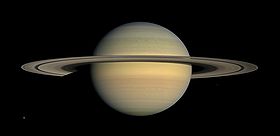
Diag. 2.
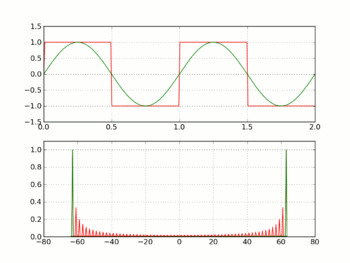
Animation of the additive synthesis of a square wave with an increasing number of harmonics
An ideal square wave requires that the signal changes from the high to the low state cleanly and instantaneously. This is impossible to achieve in real-world systems, as it would require infinite bandwidth. It would also require particles to be able to be able to travel faster than the speed of light, as the slope of an ideal square wave at these points is undefined (or infinite).[citation needed]
As already mentioned, an ideal square wave has instantaneous transitions between the high and low levels. In practice, this is never achieved because of physical limitations of the system that generates the waveform. The times taken for the signal to rise from the low level to the high level and back again are called the rise time and the fall time respectively.
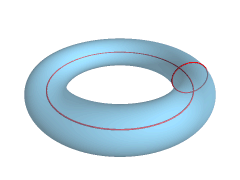
As the distance to the axis of revolution decreases, the ring torus becomes a spindle torus and then degenerates into a sphere.
R and r are also known as the "major radius" and "minor radius", respectively. The ratio of the two is known as the "aspect ratio". A doughnut has an aspect ratio of 2 to 3.
The three different classes of standard tori correspond to the three possible relative sizes of r and R. When R > r, the surface will be the familiar ring torus. The case R = r corresponds to the horn torus, which in effect is a torus with no "hole". The case R < r describes the self-intersecting spindle torus. When R = 0, the torus degenerates to the sphere.
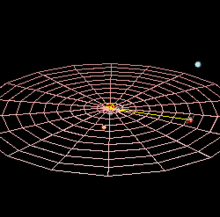
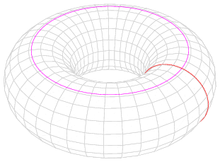
A torus is the product of two circles, in this case the red circle is swept around axis defining the pink circle. R is the radius of the pink circle, r is the radius of the red one.
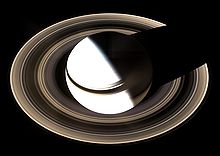
Just as a shadow is cast by a planet, a photon passes, either beside a sun or a planet, and transitions between light and darkness.
The photon is massless,[Note 2] has no electric charge,[12] and does not decay spontaneously in empty space[citation needed]. A photon has two possible polarization states and is described by exactly three continuous parameters: the components of its wave vector, which determine its wavelength λ and its direction of propagation. The photon is the gauge boson for electromagnetism,[13] and therefore all other quantum numbers of the photon (such as lepton number, baryon number, and flavour quantum numbers) are zero.[14]
If thinking of the photon as a square wave, (with a sine wave superimposed over it) (both manifestations of two dimensional or three dimensional space) it is preferable to think of the sine wave out of phase with the square wave, so its peak will coincide first with a negative ppont in the square wave, and alternately opposite the trough in the square wave. This represents both the motion of the photon as it travels through space and its average energy state as it spins (if it spins). This is because we know from Einstein, that the apparent speed of a photon from the reference point of a photon, is that all photons are moving away from each ther at the speed of light. It is a difficult concept to grasp. (more)